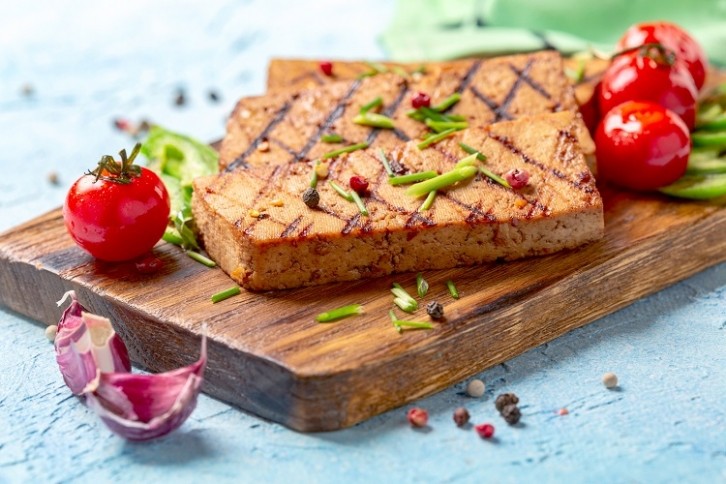The popularity of plant-based diets continues to skyrocket as increasing numbers of people make the switch from animal-based proteins in order to satisfy animal welfare, environmental or health concerns.
However, despite the fact that many plant-based protein options now offer delicious flavour, they continue to be plagued by one consistent issue, poor texture. Until now.
How can the texture of plant-based proteins be improved?
Researchers from the University of Copenhagen believe they have found a good-textured alternative to existing plant-based proteins in the form of cyanobacteria, a type of bacteria, better known as blue-green algae.
“The particularly exciting thing here is that the protein is formed in fibrous strands that somewhat resemble meat fibres. And it might be possible to use these fibres in plant-based meat, cheese or some other new type of food for which we are after a particular texture.”
“Cyanobacteria, also known as blue-green algae, are living organisms that we have been able to get to produce a protein that they don’t naturally produce,” explains Professor Poul Erik Jensen of the Department of Food Science at the University of Copenhagen. “The particularly exciting thing here is that the protein is formed in fibrous strands that somewhat resemble meat fibres. And it might be possible to use these fibres in plant-based meat, cheese or some other new type of food for which we are after a particular texture.”
The team of researchers found that cyanobacteria can serve as host organisms for the new protein by inserting foreign genes into a cyanobacterium. Within the cyanobacterium, the protein organises itself as tiny threads or nanofibers.
A plant-based protein without the ultra processing
Cyanobacteria and other microalgae have been identified as potential alternative foods. One of the primary reasons for this is the fact that they grow like plants, using photosynthesis. They also large amounts of protein and healthy polyunsaturated fatty acids.
“I’m a humble guy from the countryside who rarely throws his arms into the air, but being able to manipulate a living organism to produce a new kind of protein which organises itself into threads is rarely seen to this extent – and it is very promising,” enthuses Professor Jensen.
 Tackling texture of plant-based proteins. GettyImages/SMarina
Tackling texture of plant-based proteins. GettyImages/SMarina
A sustainable plant-based protein
There are many reasons for people to turn to plant-based eating, but one of the main ones is to support the environment. However, not all plant-based foods are as environmentally friendly as one may think.
According to the United Nations (UN), the world’s food systems generate one third of all greenhouse gas emissions and research has shown that ultra-processed foods are responsible for more greenhouse gas emissions than any other food group. A planet-friendly, sustainable plant-based protein would therefore be welcomed by environmentalists the world over.
“Cyanobacteria is an organism that can easily be grown sustainably as it survives on water, atmospheric CO2 and solar rays. This result gives cyanobacteria even greater potential as a sustainable ingredient.”
“Cyanobacteria is an organism that can easily be grown sustainably as it survives on water, atmospheric CO2 and solar rays. This result gives cyanobacteria even greater potential as a sustainable ingredient,” added Professor Jensen. “If we can utilise the entire cyanobacterium in foodstuffs, and not just the protein fibres, it will minimise the amount of processing needed.
The future of plant-based proteins
Though the discovery of cyanobacteria as a sustainable plant-based protein is exciting and could have a huge impact on the future of plant-based foods, it’s important to understand that we are looking at tomorrow’s world and it will be some time before production could reach industrial volumes.
“We need to refine these organisms to produce more protein fibres, and in doing so, ‘hijack’ the cyanobacteria to work for us. It’s a bit like dairy cows, which we’ve hijacked to produce an insane amount of milk for us. Except here, we avoid any ethical considerations regarding animal welfare. We won’t reach our goal tomorrow because of a few metabolic challenges in the organism that we must learn to tackle. But we’re already in the process and I am certain that we can succeed, says Professor Jensen. “If so, this is the ultimate way to make protein.”
In the meantime, there are plenty of plant-based sources of protein available, which require no ultra processing methods to produce, as Toni Gam from the Grains & Legumes Nutrition Council told FoodNavigator:
“Instead of swapping out animal-based protein with plant-based proteins, consider adding plant-based proteins to the meals you’re already cooking. Try adding lentils to your Bolognese, throwing some black beans into your tacos, incorporating lentils and beans into your soups, curries or stews, and adding mashed beans to your burger patties. These simple changes can improve the overall nutrient content of your meals at a lower cost.”
Source: Self-Assembly of Nanofilaments in Cyanobacteria for Protein Co-localization
Published online: 8 December 2023
DOI: https://pubs.acs.org/doi/10.1021/acsnano.3c08600
Authors: Julie A. Z. Zedler, Alexandra M. Schirmacher, David A. Russo, Lorna Hodgson, Emil Gundersen, Annemarie Matthes, Stefanie Frank, Paul Verkade, and Poul Erik Jensen
>>> Read full article>>>
Copyright for syndicated content belongs to the linked Source : FoodNavigator – https://www.foodnavigator.com/Article/2024/03/07/Tackling-texture-of-plant-based-proteins?utm_source=RSS_Feed&utm_medium=RSS&utm_campaign=RSS


























![Forest ecology cannot be reduced to arithmetic, says M.I. Varghese [Interview] – Mongabay-India](https://earth-news.info/wp-content/uploads/2025/12/328946-forest-ecology-cannot-be-reduced-to-arithmetic-says-mi-varghese-interview-mongabay-india-120x86.jpg)




